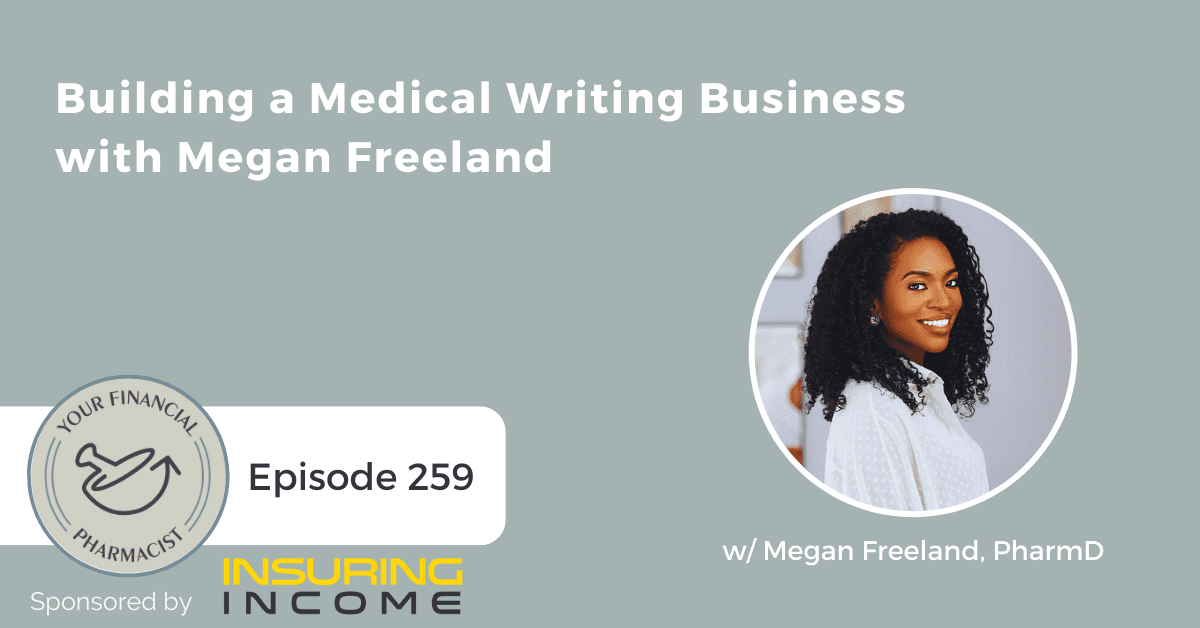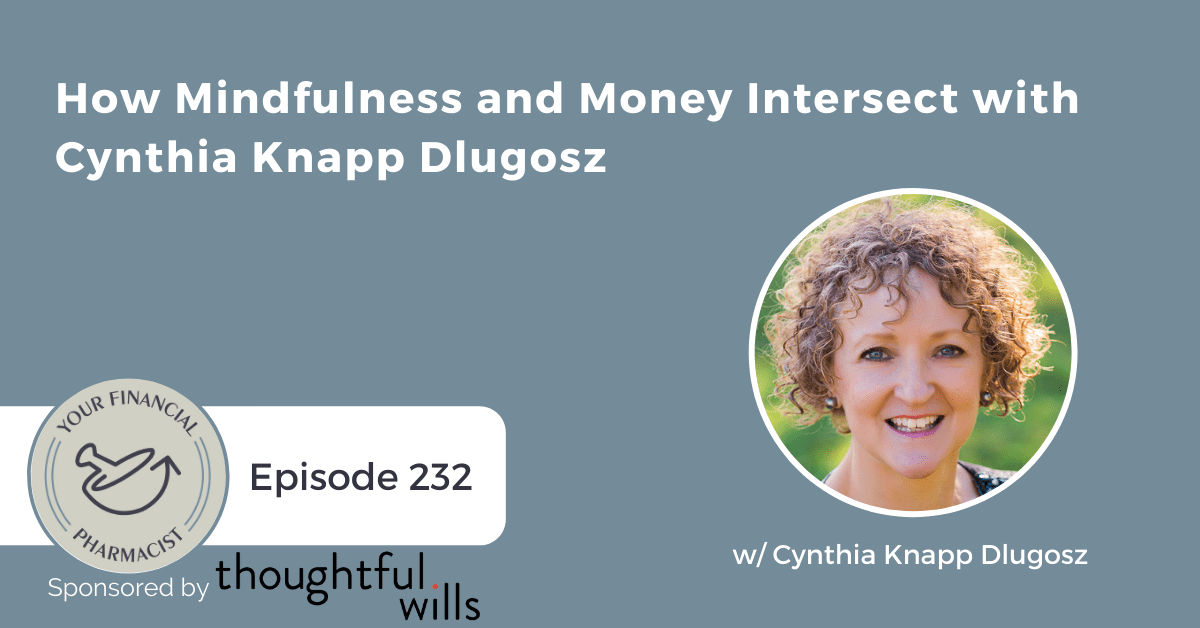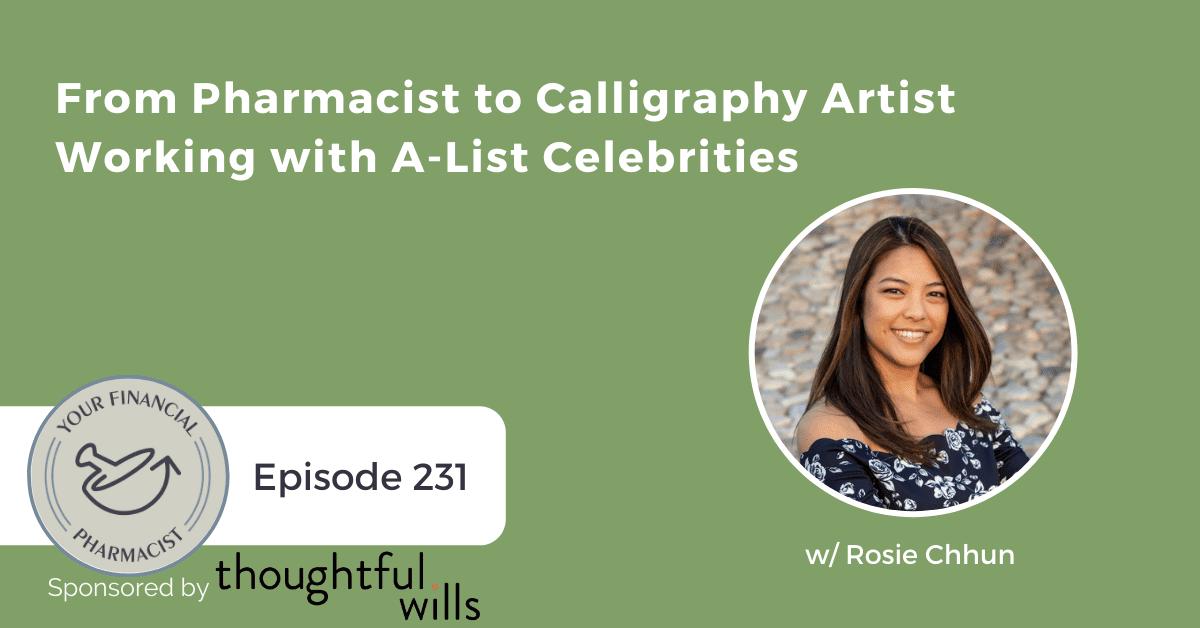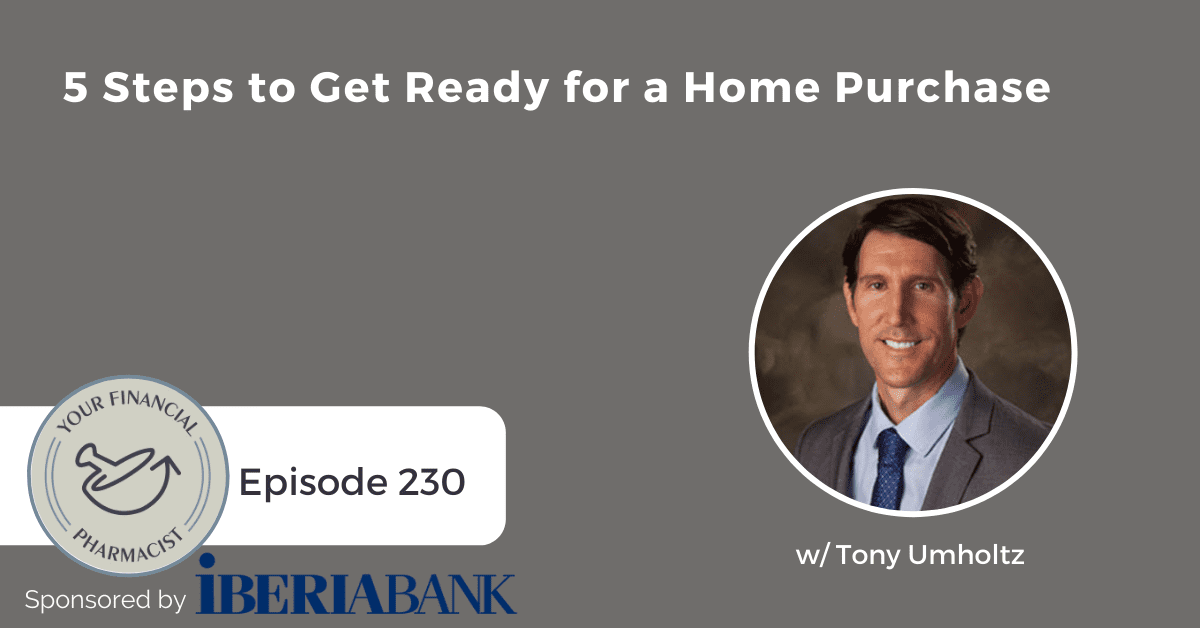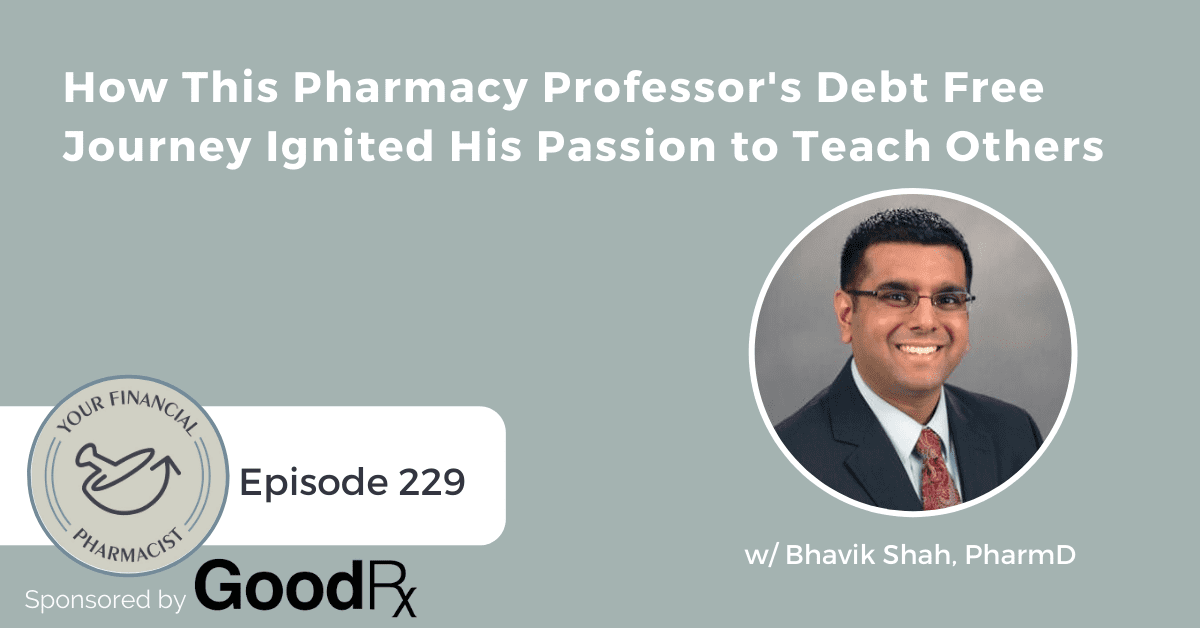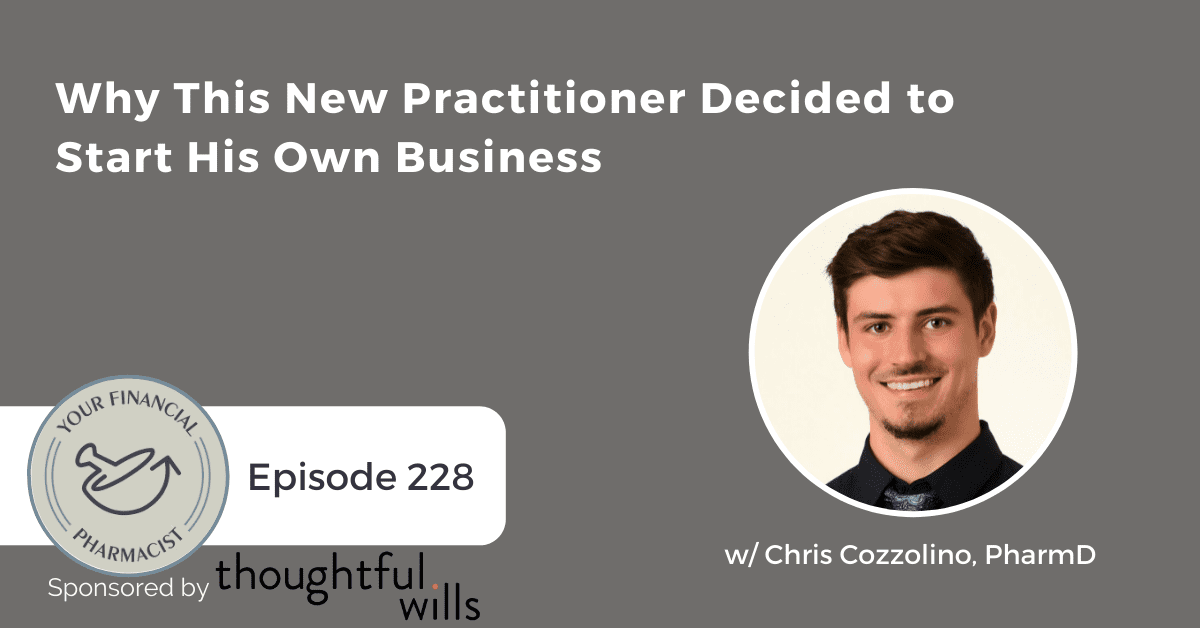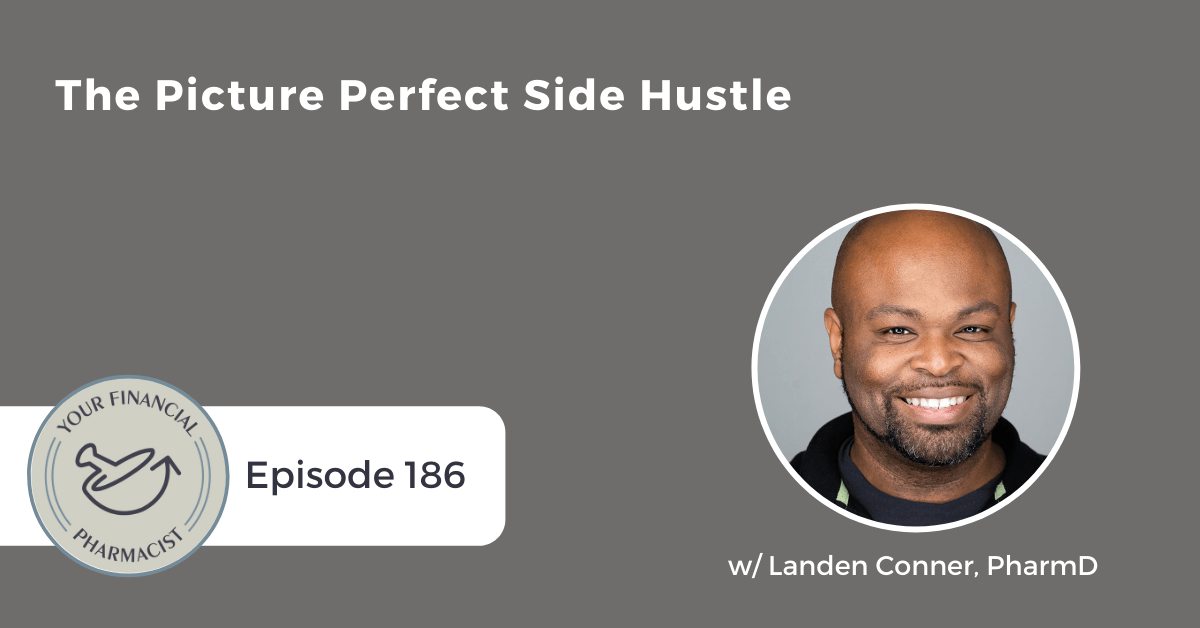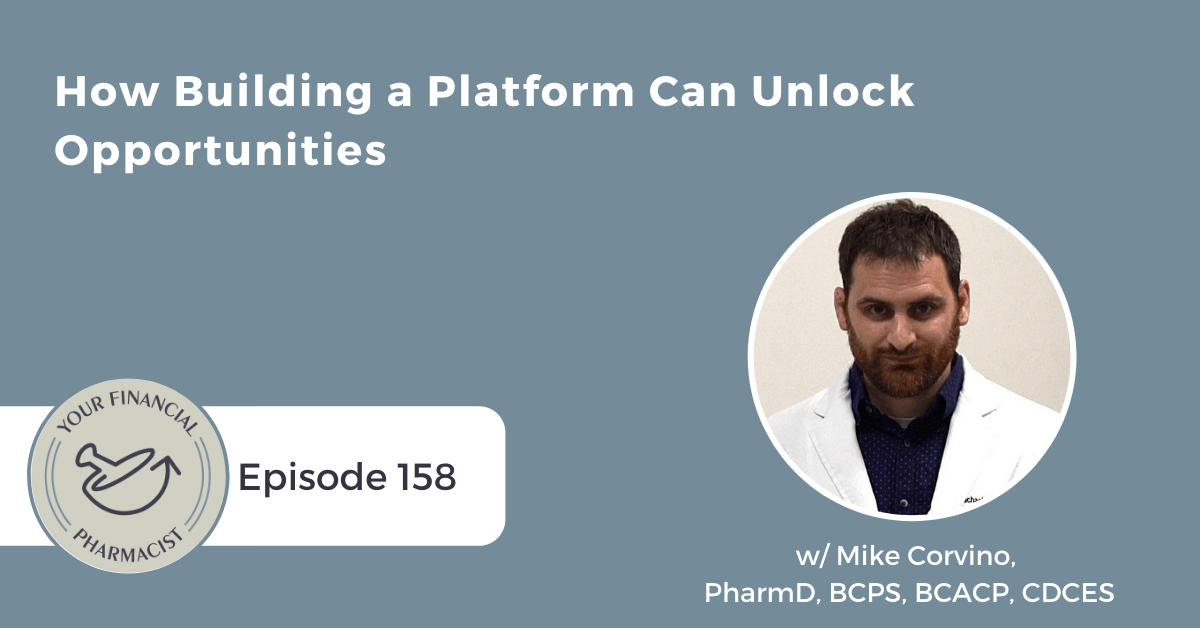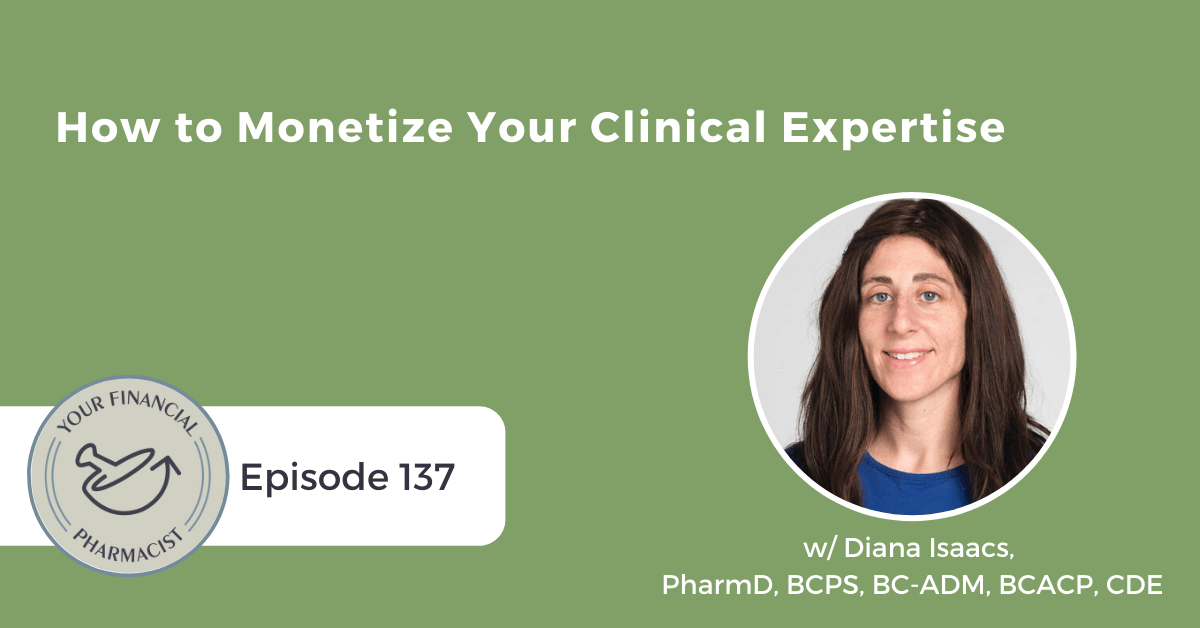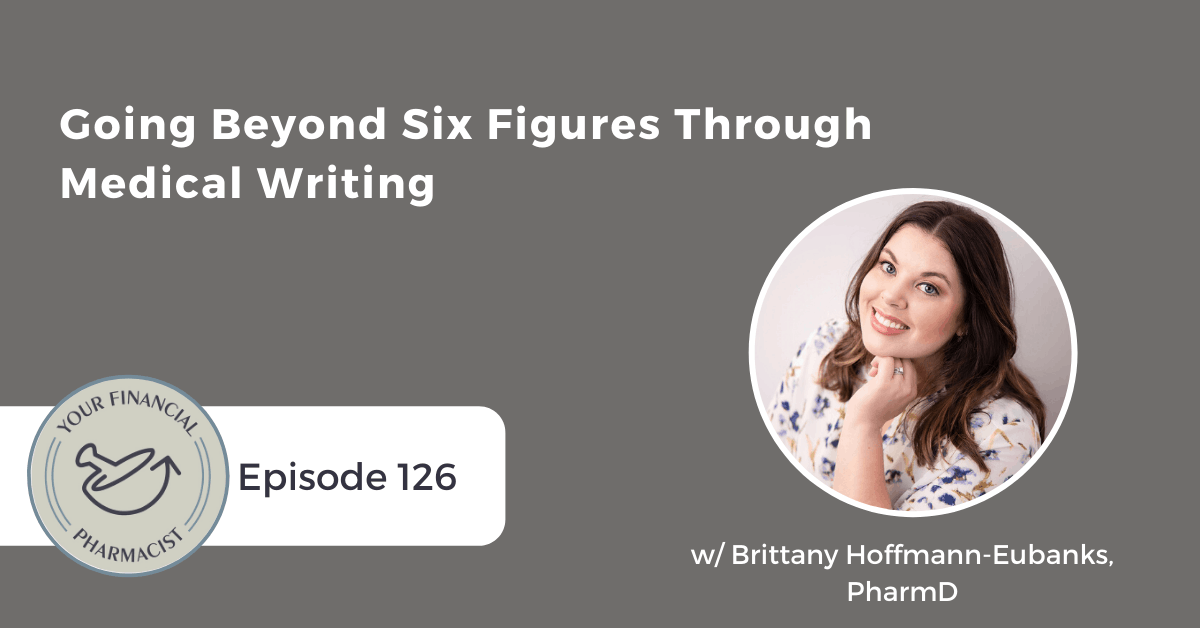Building a Medical Writing Business with Megan Freeland
On this episode, sponsored by Insuring Income, Megan Freeland, PharmD, talks about talk about her career path in medical writing, the types of health content writing that might interest pharmacists, and how she created the Health Professionals to Health Writers program.
About Today’s Guest
For the longest, Megan’s ultimate career goal was to become a public health pharmacist working for the Centers for Disease Control and Prevention. She accomplished that goal on multiple occasions — supporting divisions related to medication safety, health communications, and emergency preparedness and response — but realized she was missing the opportunity to apply a creative flair to her writing career.
Megan set out on her own to build a health content marketing company. Through StockRose Creative, LLC, Megan supports innovative health organizations, helping them use the power of words to reach their target customers and clients and turn them into raving fans. She uses a strategic approach to develop culturally-relevant content for digital health companies and health information websites. At the same time, Megan runs the Health Professionals to Health Writers program, which helps pharmacists and other health care providers learn how to replace a portion of their income through freelance health content writing.
Earlier this year, Megan also began lending her talents to an in-house communications team for the nation’s leading provider of sexual and reproductive health care and education.
When she’s not writing, reading about writing, or teaching others how to write, she’s binging podcasts and new music, scoping out the latest Peloton apparel drops, and laughing hysterically with — or at — her two young children and husband.
Episode Summary
In this episode, YFP Co-Founder & CEO, Tim Ulbrich, PharmD, is joined by Megan Freeland, a pharmacist, entrepreneur, and health content writing expert. Megan is the creator of StockRose Creative LLC, where she supports health organizations, helping them use the power of words to reach their target customers and clients. In this discussion, Megan shares how she unexpectedly found herself with a career path in medical writing after accomplishing her ultimate career goal of becoming a public health pharmacist working for the Centers for Disease Control and Prevention. Megan explains the types of health content writing pharmacists may be interested in pursuing and why many individuals get started in health content writing. She also shares how she saw the opportunity to create the Health Professionals to Health Writers program, helping pharmacists and other health care providers learn how to replace a portion of their income through freelance health content writing. Throughout the episode, listeners will discover how Megan’s passion for public health has been pivotal in the decisions that brought her to her current position. From volunteer work in healthcare centers, fellowships at the CDC, and sitting on the SNPhA board to an unexpected pregnancy, opportunities with the FDA, and more, Megan educates the listener on the art of life management while pursuing your dreams.
Key Points From This Episode
- Understanding Megan Freeland’s career by looking at her interests and background in pharmacy.
- How to apply knowledge and experience in pharmacy to the public health system.
- What opportunities Megan took to further explore public health training and experience.
- The hard journey she took to end up at her dream job in the CDC.
- Her passion and motivation for the intersection of public health and writing.
- The influence Megan’s family and community had on her passion for public health care.
- Understanding the types of medical writing and how to pursue one.
- A guide to beginning your career as a freelance health content writer.
- Megan’s ideas, goals, and motivations behind StockRose Creative.
- A look into how Megan has grown her career on LinkedIn.
- Advice for those starting to pursue their content writing careers.
Highlights
“All of the opportunities that I was taking part in to try to enhance my candidacy for being in a public health space, all of those roles and opportunities involved writing in some way.” — Megan Freeland, PharmD [0:04:33]
“People are thinking about their own experiences and their own limitations when they are thinking about what you are or are not capable of doing. Even though they have the best intentions, those ideas and those preconceived notions get projected onto you.” — Megan Freeland, PharmD [0:15:53]
“It wasn’t just my individual, nuclear, or immediate family’s health conditions that I was aware of, but we were all aware of everybody’s business. I saw how important it was for people to have good healthcare and good health information.” — Megan Freeland, PharmD [0:19:03]
“I think about the environment, information, and access to healthcare and good health information, how critical that is to the health of communities — as a black woman in the world, that level of awareness that comes with that lived experience as well.” — Megan Freeland, PharmD [0:19:37]
“You are not necessarily a reflection of the people who are trying to learn from you.” — Megan Freeland, PharmD [0:39:36]
“Your life is your own, no one else is responsible for what you do. No one else has to live with your decisions or your choices — know that you are deserving of having the professional trajectory, having the life, having the career, having the whatever that you decide you want.” — Megan Freeland, PharmD [0:42:37]
Links Mentioned in Today’s Episode
- Connect with Megan N. Freeland on LinkedIn
- StockRose Creative
- YFP Planning: Financial Planning for Pharmacists
- Schedule a free Discovery Call with YFP Planning
- Insuring Income: Get Quotes and Apply for Term Life and Disability Insurance
- Feminist Women’s Health Center
- Student National Pharmaceutical Association (SNPhA)
- CancerQuest
- Health Writing for Health Professionals
- Health Writing for Health Professionals 101 Series
- LinkedIn Creator Accelerator Program
- The Four Agreements: A Practical Guide to Personal Freedom (A Toltec Wisdom Book) by Don Miguel Ruiz
- The Big Leap: Conquer Your Hidden Fear and Take Life to the Next Level by Gay Hendricks
- Your Financial Pharmacist Disclaimer and Disclosures
Episode Transcript
[INTRODUCTION]
[0:00:00.4] TU: Hey, everybody. Tim Ulbrich here and thank you for listening to The YFP Podcast, where each week, we strive to inspire and encourage you on your path towards achieving financial freedom.
This week, I had a chance to sit down with Megan Freeland, pharmacist, entrepreneur, and health content writing expert. Megan is the Founder of StockRose Creative, where she supports healthcare organizations, helping them use the power of words to reach their target customers and clients and turn them into raving fans.
A few of my highlights from the show include Megan talk about how she unexpectedly found herself in a career path in medical writing after accomplishing her ultimate career goal to become a public health pharmacist working for the CDC, the types of health content writing that pharmacist may be interested in, pursuing and the main reason that individuals get started in this field and how she saw an opportunity to create the health professionals to health writers program where she helps pharmacists and other healthcare providers learn how to replace a portion of their income through freelance health content writing.
Before we jump into the show, I recognized that many listeners may not be aware of what the team at YFP planning does in working one-on-one with more than 240 household in 40 plus states. YFP planning offers fee-only, high-touch financial planning that is customized for the pharmacy professional. If you’re interested in learning more about working one-on-one with a certified financial planner that may help you achieve your financial goals, you can book a free discovery call at yfpplanning.com.
Whether or not YFP Planning’s financial planning services are a good fit for you, know that we appreciate your support of this podcast and our mission to help pharmacists achieve financial freedom.
Okay, let’s jump into my interview with Megan Freeland, Creator of StockRose Creative.
[SPONSOR MESSAGE]
[0:01:42.8] TU: This week’s podcast episode is brought to you by Insuring Income. Insuring Income is your source for all things term life insurance and own occupation disability insurance. Insuring Income has a relationship with America’s top-rated term life insurance and disability insurance companies, so pharmacists like you can easily find the best solutions for your personal situation. To better serve you, Insuring Income reviews all applicable carriers in the marketplace for your desired coverage, supports clients in all 50 states, and makes sure all of your questions get answered.
To get quotes and apply for term life or disability insurance, see sample contract from disability carriers or learn more about these topics, visit insuringincome.com/yourfinancialpharmacist. Again, that’s insuringincome.com/yourfinancialpharmacist.
[INTERVIEW]
[0:02:34.4] TU: Megan, welcome to the podcast.
[0:02:36.0] MF: Hello, Tim. I’m so excited to be here with you, thanks for having me.
[0:02:39.8] TU: I too am excited. We had a chance to connect several months ago and I’ve been excited to do this interview to share your story, your entrepreneurial journey with the YFP community. Let’s start off by hearing about your background, where did you go to pharmacy school, and what ultimately was some of your interest in going into pharmacy in the first place.
[0:02:57.6] MF: Great question and thank you for orienting me with this question, because whenever I get that background question, I’m like, “Where do we start?” I went to undergrad at Emory University and then I stayed in Atlanta for pharmacy school to attend Mercer University. When I went into pharmacy, I did not necessarily go into the field with the intention of practicing in the traditional sense.
When I was still in undergrad, I was trying to decide whether I wanted to pursue public health or whether I wanted to pursue pharmacy and I was encouraged by family members, my mom namely, to go into pharmacy because she was frankly disappointed that I decided that I did not want to go to medical school anymore and her thought was, “Well, at least, if you go to pharmacy school, you still come out with a doctorate degree.”
So I listened to mom and I chose to go to pharmacy school but I still had that public health bug in the back of my mind and so, my goal was to figure out, “Okay, how can I apply the experience, the knowledge that I gained through the pharmacy program to a public health setting?” How can I become essentially, a public health pharmacist when I leave?
Obviously, didn’t have a whole lot of guidance or examples to look to because at that time and even still now, there weren’t a whole lot of people who were kind of going down that public health path with the pharmacy background. So what was very much four year period of trial and error and kind of figuring out where I landed and how I could make that happen and what I noticed was that all of the opportunities that I was taking part in to try to enhance my candidacy for being in a public health space, all of those roles and opportunities involved writing in some way.
So, once I noticed that pattern, I decided, “Okay, well, this is kind of naturally the course that I’m going along, so I’ll just keep doing this and see where it takes me.”
[0:04:56.8] TU: It’s really interesting, Megan. I think it’s rare that someone goes into the pharmacy degree with a thought of a non-traditional career path these days. One example that I am passionate about is that my hope is that we can begin to see the PharmD education as being more of a gateway to many different opportunities and you know, not just one or two different pathways which folks may typically associate with.
So I think that’s really neat to hear that someone entered in with that non-traditional path and let me ask you a follow-up to that then, as you went into pharmacy school with a specific interest in public health, which isn’t a surprise, right? Emory University is known for their public health training, what specific opportunities did you look for in pharmacy school to further explore and build upon that interest?
Was there an organizations, was there specific internships, or rotations you’re able to get more experience, tell us more about how you’re able to foster that interest during pharmacy school?
[0:05:51.3] MF: Yeah, I love that question. And yes, that was not coincidental at all, actually, I’m originally from Columbia, South Carolina, and in the 9th grade, my magnet program, we took a field trip to Atlanta, and during that trip, we toured Emory and we also toured the CDC, which is right next door to Emory. So in the ninth grade, I decided, when I go to college, I’m going to Emory University and I’m going to work for the CDC.
So, it kind of was like a full circle situation but when I got to pharmacy school, I noticed that a lot of the extracurricular opportunities, the clubs, the programs, they were all pharmacy-related and so for me, I felt like, “Yes, I could do these things but will they really help me in the public health setting?” I’m going to have the degree, that takes care of my pharmacy qualifications.
I felt like anything that I was doing outside of going to class and taking tests needed to be more specific to public health in some way and so because of that, I was actually looking for opportunities outside of my school’s ecosystem because those were not what I felt like I needed to increase my candidacy for public health.
I looked at community organizations, I ended up volunteering at a center called, The Feminist Woman’s Health Center in Atlanta. They do a lot of education around sexual and reproductive health and I ended up volunteering on their health and education training committee for all four years of pharmacy school.
I looked into the CDC to see what types of internships or fellowships they offer that pharmacy students were eligible for. So, the summer after my second year of pharmacy school, I completed a CDC fellowship, it was called the Emerging Infectious Diseases Fellowship and it lasted for nine weeks, you were paired with a mentor, you actually worked on CDC teams, worked on a project, presented, everything.
I traveled to Panama for an epidemiology investigation in a Panamanian hospital. Those are like two of the core examples but any other time that I was engaging in extracurriculars, I made sure that they were related to public health in some way. One more that I just thought of, I was a part of SNPhA, the Student National Pharmacist Association and I participated in some of their community service projects because again, those are more public health facing educational opportunities.
I always had that lens and that perspective whenever I was doing anything outside of going to class, taking tests, and trying to get my degree.
[0:08:34.8] TU: I love the intentional and I hope if we have any students listening, they go back and rewind and listen to that because the message I hear there is that sometimes we got to get outside of the walls of the college or pharmacy to explore other opportunities and again, the PharmD can be used in so many different ways and I think your story here is a great example of that but sometimes it takes some creative thinking and it takes some initiative to see what those opportunities may be.
Tell us more one of the things you shared to me before is that you know, working for the CDC was a dream for you and you’re ultimately able to achieve that. Tell us more about what happened right after you graduated from pharmacy school. So it was during school, you identify this growing interest in public health, you see the connection to writing and then you have an opportunity to do an industry, fellowship as well as some work with the CDC thereafter, tell us more about those experiences.
[0:09:22.0] MF: Yeah, as I was going through pharmacy school and kind of collect these experiences that I hoped would be helpful for me in the future. I was also trying to think about what the immediate step post-graduation would be. My goal was to go straight back to the CDC after graduation. Those are the opportunities that I was most excited about and most intentional about but it wasn’t working out.
I wasn’t getting any opportunities that would be timely for me to start right after graduation and so I said, “Okay, if I can’t get to the CDC right now, what are other opportunities that I could take part in that were still public health-related that would still help me get back to CDC down the line?” So I looked into industry fellowships and I was specifically attracted to one program in particular because it had an FDA rotation as a component of the fellowship.
I graduated in 2015. So, at that time, it was one of the only industry fellowships that had any type of public health rotation as a part of it. It wasn’t like I had all of these choices. I did apply to many more programs because I would have made it work but this one, in particular, was of interest to me because of the FDA component and so that’s the fellowship program that I ended up getting accepted into.
Ironically, I got pregnant unexpectedly during the first year of my fellowship and so I never actually made it to the FDA rotation of the program. I was in the middle of my second rotation when I found out I was pregnant. What happened at that point was that I was located in New Jersey, the portion of my fellowship I was in at the time was the medical information rotation for Johnson Scientific Affairs, which is the pharmaceutical arm of Johnson & Johnson.
I was in New Jersey and I’m like, “Okay, well, I need to move back home” where my now husband but boyfriend at the time was and we have to get ready for it to be parents and so, I’m like, “Well, that also means I need a job because I can’t do my rotation from Atlanta” you know, maybe if it was 2020 or 2021, things are different now, maybe that would have worked out but at that time, basically, we just brought my rotation at one year instead of two.
I went back to the CDC drawing board, I was looking for fellowships, I was also applying to a whole bunch of other jobs mind you because like, this was survival at this point in time. It wasn’t about my preferences, I just needed a job in Atlanta but I was also looking for CDC opportunities and I saw this opportunity that was in the same department that I had completed my fellowship program in during pharmacy school.
I reached out to my mentor from that fellowship to ask her if she knew anything about the position, she wasn’t the hiring manager but she knew the person who was and so she connected me with that person, I went through the application, the interview process, everything and I got that position. I ended up back at the CDC, back at home in Atlanta, preparing for, to become a parent, and a lot of this story that I tell, it’s important for me to say that like, it sounds great now but that’s because I’m reflecting on past experiences, right?
Hindsight feels a lot better but all this journey was not easy. Even during pharmacy school, when I was engaging in all of these non-pharmacy specific projects, it was uncomfortable because I didn’t know if what I was trying to do was actually going to work and I had a lot of people who meant well, advisors, faculty members, in my ear, saying that I needed to go another route.
Similarly, with the fellowship experience, I was very disappointed in myself for not being able to complete my fellowship and I had three preceptors, which meant I had to tell three different people, “Hey, sorry, I’m pregnant and I can’t finish the fellowship” but they were all super supportive and when I got that role back at the CDC, one of my, I probably shouldn’t have favorites but one of my favorite preceptors said, “You should be proud of yourself because this two-year program was supposed to prepare you for a role like the one that you just got, not even nine months into your fellowship.”
“You should feel very proud of yourself.” I burst into tears because I was emotional and it was a lot going on, that really helped me put it into perspective. So that’s how I got back to the CDC. I should also add, the fellowship that I completed was in drug information and the CDC fellowship that I started after the one year of my fellowship was in health communications.
[0:14:10.0] TU: And we’re going to come back to more of the expansion on the interest and writing and where that has led to the work that you’re doing today. I want to come back real quick, Megan. You said something really important which I want – especially if we have any students listening. I want them to hear is that, you were given advice by several folks that I think, probably had good intent that maybe you should consider a different pathway and I can tell you from being in the academic environment for several years, we like very linear pathways, right?
We like very linear pathways where we know this opportunity’s going to lead to that opportunity and your pathway wasn’t necessarily linear in that you were coming in with somewhat of a nontraditional interest. You were getting different experiences but what you were doing is you were planting a lot of seeds and building a lot of relationships that sometimes it takes time for those to grow, right?
To flourish and I just love the passion and the interest that you had and continuing to pursue that, despite perhaps some outside noise of, “Maybe you might consider this and maybe you might consider that” and I think the lesson I hear there is, pursue the interest, plant the seeds, trust he process as you’re continuing to move forward and it might not always feel like one dot is going to connect to the next but I think as you shared in hindsight, you can start to appreciate how some of those things come together.
[0:15:24.3] MF: Absolutely. Trust the process and also trust yourself. One of the people who was encouraging me to do a residency which that’s what everybody was telling me to do, even my mentor at the CDC, understanding that I wanted to follow in her footsteps like once I found her, I was like, “You’re the person who I want to be like” and even knowing what my intention was, she was like, “You know, I really think you should do a residency first” and I’m like, “I hear you,” but what happens is sometimes, people are thinking about their own experiences and their own limitations when they are thinking about what you are or are not capable of doing and even though they have the best intentions, those ideas and those preconceived notions get projected onto you.
It’s really important to trust yourself enough to be able to examine what your thoughts, your preferences, your intentions are as well as the advice from trusted people but then to make your own decision based off of all of that information, including your own desires and intentions.
[0:16:26.9] TU: That’s one of the passion that I have and I’m not going to get on the financial soapbox because I do that in every other episode but that’s one of the challenges I have in our profession is that, they’re so often is the financial pressure of the student loans, the golden handcuffs of that six-figure income that folks that might be thinking about something more nontraditional or not as structured in terms of, “I’m going into residency, I’m going to go into fellowship, I’m going to go make this income” it can just be hard to have the space to explore that when you have those other pressures that are there.
I want to come back and ask you, you’ve really done a nice job I think of outlining this interest that you have in public health and an interest in writing, we’re going to come back and talk more about that but I didn’t ask you, what is the why behind that? Where did that passion come from in this intersection of public health and writing and what really motivates you and inspire you towards the work that you’re doing?
[0:17:14.1] MF: That’s a good question and one that I don’t think about as often. I can say that my interest in writing, I wouldn’t call it a passion at this present time or at the time that it started but my interest in writing actually came from a work study job that I had when I was at Emory. I was lucky enough not to be assigned to like putting books back on the shelves at the library the way a lot of our friends were for work study but I had a job with CancerQuest, which is a patient education website that was associated with Emory’s Winship Cancer Institute, and my role for CancerQuests was basically to update and write a lot of the patient education information that was on the website.
So that was like a huge directory of all these different types of treatments, preventative measures, therapies for different types of cancer and so I had to do a lot of research and write information that could be interpreted by the general public. It was kind of my first taste of health communications but I did not have the language to be able to say, “This is what this is.” I would say, from that point that kind of planted the seed for my interest in medical writing and health communications, although I didn’t realize it until probably a decade later.
Public health, I think that’s just something that has been a part of my experience as a person in the world. Like growing up in Columbia, South Carolina, amongst my family members who dealt with their own personal health issues, we were in a very communal environment. So in my neighborhood, like, my grandmother knew all the people on her street, all the people on her block, we were all kind of family.
Because of that, it wasn’t just my individual, like my nuclear or immediate family’s health conditions that I was aware of but we were kind of all aware of everybody’s business and so I really saw how important it was for people to have good healthcare, good health information and again, I wouldn’t have been able to verbalize this as a child but looking back, all of this information was kind of more abstractly in my brain at that time.
I think that just as I progressed throughout school, like K through 12, undergrad, I started to think more concretely about how environment and information and access to healthcare and good health information how critical that is to the health of communities and I think that also, just kind of as a black woman in the world, that level of awareness that comes with that lived experience as well, public health was just something that kind of called my name.
When I went to that field trip in the 9th grade, and toured the CDC, I think that was probably the first time that I was able to connect the actual field of public health with all of that previous life experience that I just named.
[0:20:13.5] TU: Admittedly Megan, my knowledge related to medical writing, health writing, health content writing, we’ve used our term health communications is pretty elementary and I’ve seen these terms used in different ways, and for folks that are listening, thinking about, “Hey, maybe I’m interested in entering this field” and whatever way that may be, break those terms down a little bit further for us.
What are the differences between those and the types of writing opportunities that folks maybe able to pursue?
[0:20:40.5] MF: So this is a juicy question because there are so many routes that a person could take, depending on what their interest are. So if we kind of backup and go to the most high-level area of this, when we talk about medical writing, like you, many people are using that term, interchangeably. Some people might describe what I do health content writing as medical writing.
It’s not that there is anything wrong in particular with using that language, but, I think what some people don’t realize is that medical wiring is more of an umbrella term that could actually describe a lot of different types of writing. Same thing with health writing. So when I talk about broadly and holistically, this space, you will sometimes hear me say medical and health writing, that’s because those are the broadest terms that describe all of the individual types that come down from that.
When we get to talking about like specific examples, you’ve heard me reference specific examples during this conversation, right? You heard me reference a drug information fellowship, a health communications fellowship, I’m a health content writer, it really depends on who is the audience and what style of writing is being done. Those are like, the two big buckets that can kind of help differentiate the different types of medical writing.
Medical writing, I typically think of those types as writing that’s geared towards a clinical audience, an audience of health professionals, an audience of scientist, it’s typically more formal in nature and the topics are often times more specific to medicine, like actual treatment, prevention, therapies and so some specific types of medical writing would be drug information that adhere to a clinical audience.
Another type would be scientific writing, another type would be regulatory writing. So you will see a lot of regulatory positions at pharmaceutical companies because there are people there who are writing INDs, they’re writing documents that need to go to the FDA or to different regulatory associations, so that’s definitely a type of medical writing. Scientific publications is a type of medical writing.
Medical communications, so these are companies who are sometimes contracted by pharmaceutical companies to create materials, to educate other health professionals, right? So if you want to put together a slide deck or a post of presentation to present at a conference, that’s often happening at medical communications companies. So, all of those are examples of medical writing, which is often times again, a more formal and geared to a clinical or health professions audience.
Then, on the other side of that, you have the other umbrella term of health writing. Health writing, I typically think of as geared to a more lay or general public audience and the topics are not always so scientific or medical. They could be more wellness oriented or more health oriented but health oriented from the standpoint of how does an individual person apply this information to their actual life, not health oriented as in like all of the science of like how this drug works or blah-blah-blah.
Specific examples of health writing are health communications, the fellowship that I mentioned at the CDC. In that position, I was basically like a liaison between our research team and the general public. So when they would come up with their research, I would create fact sheets, blog post, maybe sometimes op-eds, talking points that could go on the website that regular folks could understand.
There is also health journalism, which is when you go to the Washington Post or you go to health magazine, those articles that you see in there, those are forms of health journalism and then my personal favorite, health content writing. We’ll probably dive more into content writing but broadly content writing is information or education that’s presented online in most cases that help someone solve a health problem or answer a health question.
One of the most common ways that content writing becomes visible is when you go to Google, right? If you’re a mom, a new mom at 4:00 in the morning and you baby is not latching and they won’t go to sleep and you go to Google and you say, “Help, my four-month-old isn’t latching” the information that comes up, some of it might be like forums, parent forums but the articles that come up often times those are examples of health content writing because they’re helping you answer a question or solve a health problem that you have.
[0:25:23.7] TU: That was great. I mean, probably the best explanations I’ve heard and I know you have my mind spinning of, “Okay, if I am thinking about this as a potential side hustle or career opportunity, okay, what are the different ways? What might be my strengths or interest?” What would yours that I’d want to pursue? So the examples there were really helpful. I have heard you talk before about three main reasons that folks may get started in medical and health writing.
Those could be number one, they want to influence the public health on a larger scale, number two is to use their degree along with a healthy dose of creativity and number three is to create an additional stream of income outside of their clinical career. My question for you knowing that you coach many other pharmacists and other healthcare professionals that are exploring this area of writing, do you see one of those resonate more than the others or are folks often entering into this space because of all three of those or some combination of them?
[0:26:18.1] MF: That’s a really good question. I think most people have – I will answer this question in two ways, there are people who are interested and then there are people who take the steps to pursue. Those are often two different types of people, so people who are interested of course can have any of those three reasons. It could be relevant but I find that often times the biggest draw is the additional stream of income.
But what happens is once they realize how much work it actually involves to get to the point where they are qualified to be a health content writing, only having the interest of an additional stream of income is not enough. It’s not enough –
[0:26:59.0] TU: It’s not a strong enough why right?
[0:27:00.0] MF: No, it’s not at all because the return on investment yes, could be there because like you can make a whole living out of health content writing and plenty of people do but to get to that point where you can even do that, the time that it takes to learn the skills, to create the portfolio, to go out and find clients, only being motivated by the money is oftentimes not good enough.
The students that I work with and even students, that pharmacists that do decide to pursue health content writing but they choose another route or aren’t necessarily in my program, I find that there is more of that interest in really influencing public health and utilizing their degree in a way that brings them fulfillment and joy and opportunity to actually educate people, which is something that we are often sold on during pharmacy school.
But in reality, in real life once you get out into the workforce, sometimes it’s not really a major piece of what you are able to do in your workspace. So a lot of the students that I work with express to me that of course, they love to have some extra money because you said it earlier, loans and debt and family but what they’re really looking for is a way to find more fulfillment and joy within their profession.
There are lots of side hustles, other opportunities that people could engage in to make money but people don’t necessarily want to let their degree and their education and their experience go. It is not that they don’t love pharmacy or love healthcare, it’s that maybe they don’t love the way that they have to execute it in their full-time roles. So if there’s a way for them to still use the background that they have in a more fulfilling and impactful way, then they’re very into that.
[0:28:50.0] TU: So well said, you know, often I say and feel myself that forward progress and growth is such an important factor for us as individuals and human being, that we have a feeling of growth that we’re developing ourselves and I think for many pharmacists that may be are feeling stuck or they aren’t feeling that growth or they aren’t feeling like they’re using their degree to their full potential, that can be a suffocating feeling.
I often say that side hustle’s income that’s a nice symptom but really what we want to be focusing on I think in part and not overlook is, what’s the motivation, what’s the purpose, what creative outlet is this providing and that’s a hard benefit to measure but don’t underestimate it because it’s so powerful especially if you feel like you’re in a situation where you’re stuck. It’s so powerful to feel like you’re growing, you’re developing and you’re moving forward.
Let me ask you a question I’m sure you get all the time, which is: can I work full-time doing this? Is that a viable pathway to grow a medical writing business?
[0:29:49.3] MF: Yeah, so I’d say that the answer is emphatically yes. When I started out as a freelance health content writer, I had a full-time job. I will do a quick aside to address something that you just brought up in terms of having that source of fulfillment is I was in a job that I did not like. It was my third time at the CDC and it was a regulatory writing job and it was not my most exciting role and so I started blogging on the side just because I needed a creative outlet.
That really helped me when I was in that full-time role that I didn’t like because I had something that was going on that was interesting to me and so that was exactly how I got started as a health content writer. I had a full-time job at the time, it was accidental because I was not yet aware that health content writing was a field and so when I started my blog, it just so happened that a health company saw it and reached out to me and asked if I was right for them.
That was how I first freelance writing opportunity but it wasn’t until a year and nine months later that I actually left my full-time job for that entire year and nine months, I was freelancing on the side. So it’s definitely possible, I would say it is definitely one of the most common approaches. If you are in a position where you are just learning the skill of freelance health content writing, I don’t know what your financials are like.
If you have a couple of tens of thousands in the bank and you can afford to just shut your full-time work down so that you can focus on freelance health content writing, that’s definitely open to you but for most people, it’s going to take time to even get the foundations that you need to be able to get started and then once you start, it’s going to take you some time to get your feet under you and get to the point where you can bring on more and more clients.
So, in most cases, it actually makes sense to start with a full-time job so that you are not reliant upon this income source that you haven’t yet created. So definitely possible, it just takes time management and availability of time as well.
[0:32:02.2] TU: Yeah and I am a firm believer as you kind of were eluding to there that building a business upon the back of a strong personal financial foundation is so important, right? Because you can approach that opportunity with less stress, you can approach that opportunity with confidence and perhaps some folks can manage to make that jump and not to have that stress still if they have additional savings.
But I think for many, having that full-time job will allow them to pursue that opportunity with confidence and to minimize that stress. Talk to us about StockRose Creative, the company that you’ve started and have been growing, talk to us about what it is, how it came to be and what are the services that you offer?
[0:32:38.4] MF: Yeah, so StockRose is the business entity that I created when I decided to go full-time in my health content writing work. Unlike the students that I work with, I did not have real guidance when I got into the health content writing space. I was just out here figuring it out on my own and so because of that, I dabbled in a lot of different types of writing through StockRose before I landed on health content writing solely and before I got even narrower in the specific types of writing services that I was offering through health content writing.
Today, what that looks like is I offer blog writing and video scripting services particularly for digital health companies and especially if those digital health companies have audiences that are primarily black or they have portions of their audiences that are primarily black and the reason for that is because content writing is a very small piece of content marketing. It’s a much broader process and so a part of what you had to do if you’re interested in being a freelance health content writer is you have to understand how that fits into the broader process.
With that, strategy is a part of the process that has to come before writing and sometimes companies, they do not have that strategic part in-house and so I consult with them to say, “Hey, if you have audiences that are black or primarily black, you’re going to have to develop a different content strategy in order to actually have content writers that are writing effectively for those audiences.”
That’s the core service that I provide but it did not start out that way, it was much more lose and difficult to define because I was figuring it out as I went along. So that’s kind of the service part of my company and then the coaching part of my company, I’ll kind of give some context to how that came about. I really sat down one day and thought, “What is the theme of my professional career?”
I’ve had a lot of different roles and they’ve all had writing in common but beyond that, what kind of links everything together? I realized that in all of my past, fighting health misinformation and putting out good health information has been the theme that connects everything together and is what I’m passionate about and what I want to continue doing into the future and so if I want to fight health misinformation, which is getting more rampant by the minute it seems, I am not the only person who can or should be doing that.
There are more people and specifically, healthcare providers who should be doing that. The problem is that most healthcare providers don’t have experience in health content writing or creating online content. It is not because they can’t do it, it’s just because they don’t have the exposure or the experience in order to be able to do it. So the question is, well, how do they get that? Technically, I could hire them.
However, I am not particularly interested in running an agency or managing other writers like that’s just when you get to the point where you’re running an agency, it often takes you out of the actual execution of whatever the service that you’re providing and you become a manager and my passion is about the creation of the health information. So my question was, “Well, how do I help other healthcare professionals become health writers so that they too can be able to counter the misinformation that’s out there?”
I decided that creating this accelerator program called Health Professionals to Health Writers, where there is didactic teaching to make sure people have the foundational knowledge of content marketing that they need, where they are able to create the portfolio of samples that they need to actually get freelance gigs and where they actually build out the business processes they need to know how to go out and secure clients.
That would be the way to help more professionals have the skills and the experience that they need to be freelance health content writers as well. So that’s what my coaching side of StockRose does under the Health Professionals to Health Writers accelerator program.
[0:36:58.0] TU: I love that and I think that aligns so well with your why, right? Of how you got into this in the first place. You talk about fighting misinformation and looking at doing that on a broader scale, the impact of that is you coach up and train up other pharmacists, other healthcare professionals, the impact of that is going to be much greater than your writing alone or even a team or writing if you did go with that approach.
We’ll link in the show notes, that’s stockrosecreative.com, folks can go there. We’re also going to link in the show notes, you have a Health Writing for Health Professionals 101 series on YouTube, and then folks can also learn more about the accelerator program that you mentioned as well, some of the work that you’re doing. I do want to ask you, this is somewhat of an aside, but I think a really cool accomplishment, I’ve been following your work on LinkedIn, and I saw you recently went through the LinkedIn Creator Accelerator Program as a part of the first class of a 100.
First of all, congratulations on that accomplishment, that was fantastic. What did you take away from that program about yourself and about leveraging LinkedIn as a platform to help grow your business?
[0:37:57.2] MF: Thank you, Tim, for the congratulations. That was probably one of my most exciting accomplishments of last year. I was literally in tears when I got the email that I got into the program and I do also have to shoutout Brian Fung, who was the one and only other pharmacist in the first 100 with me, so we had a great time. I think the most important thing that we took away from that experience was how important it is to really be intentional about the content and the information that you’re creating not just on LinkedIn but online in general.
That might sound odd because as a health content writer, that’s exactly what I do but I think the most important part here is thinking about there’s always an audience that you are sharing information to. If you are ever creating any content whether it’s health content or social content or anything, if you are creating that just for you, then you are really missing an opportunity to connect with the people who are following you and watching you and listening to you.
Because they often times have different perceptions, leads, preconceived notions than you do and so, whenever you’re creating content, this applies to health content writing as well, you really have to be less focused on what you think and what you already know and really dive into what your audience thinks, what they do and don’t know so that you can create that content in a way that helps address their questions and helps solve their problems as accurately as possible.
You are not necessarily a reflection of the people who are trying to learn from you. If I were creating content on LinkedIn just for me, I would be going over the heads of so many people because I’ve been a content writer for five years. There are people, pharmacists who are coming across my account who have literally never heard of health content writing before. Students that I’ve worked with are like, “I did not know what this was until I saw your post.”
If I am not keeping that in mind and really trying to get a sense of where people are, then I am missing the point and the same holds true for any type of content that you are creating for any reason, paying attention to what your audience thinks and what they need.
[0:40:17.9] TU: I hope, folks, if they are not already following you on LinkedIn, they’ll be able to see that in action, so I hope they will. We’ll link to that in the show notes, Megan N. Freeland on LinkedIn. All right, my last question here for you, Megan, you had a post on LinkedIn recently that caught my attention and I didn’t prep you for this question, so this is going to be a discussion but you said:
“When you’ve worked so hard to get to a certain point, people may tell you to just be grateful that you’ve made it there. The sentiment implies that asking for anything more is mere greed. To that I say, don’t you dare dim your light for anyone else’s comfort. You can be grateful for your journey without having to stay there. We are all allowed to grow, mature, and evolve. Going after the career you want and the life you desire is not selfish, it’s your right and most importantly, it is within your power to do.” Tell us more.
[0:41:10.0] MF: Okay, hearing that read back to me that kind of got me in the heart a little bit. This kind of goes back to what I alluded to before about trusting yourself and recognizing that people might have your best interest at heart, or they might think that they do but they will also set limitations on you based on what they think is possible and what they think is fair and what they think is possible for them to do.
Sometimes, when you’ve worked really hard to achieve this goal, let’s say the goal is just graduating from pharmacy school, that might have been an expectation that either people didn’t have for you or people don’t have for themselves and so when you get to that point and if you turn around and realize, “I am proud of myself and I am glad that I accomplished this goal but I don’t feel completely settled” right?
I still feel like there’s something out there more for me, I still feel like maybe I am not in the exact place that I should be, maybe I’m close but maybe I’m not quite there, if you express that feeling to people, there are people who might say, “What are you talking about? You’re a pharmacist, you graduated, you should be grateful. I am over here doing XYZ, that’s not as cool as being a pharmacist, you have nothing to complain about” and that’s not about you.
That type of response is not about you, that’s about them and so my advice to anyone in this situation is your life is not anyone else’s. Your life is your own, no one else is responsible for what you do. No one else has to live with your decisions or your choices and so, regardless of how people respond to your discomfort or your feelings of unfulfillment or whatever it is, know that you are deserving of having the professional trajectory, having the life, having the career, having the whatever that you decide you want.
That’s within your control, that’s within your power and frankly, it is not for anyone else to comment on at all but if you say it to people, they will comment but just keep in mind that you determine all of that stuff. You determine the trajectory and you don’t have to feel guilty about that because it’s your life and you’re the only person who’s responsible for it.
[0:43:27.2] TU: So powerful, Megan, great said. It reminds me of a couple books I read and reread recently that I’d highly recommend, The Four Agreements, is one and the second one is, The Big Leap by Gay Hendricks. We’ll link to those in the show notes but those, both of those books get exactly to what you just shared there and that is so important for other people to hear especially for folks that are out there creating, putting content, stepping out in non-traditional ways like if you don’t work through that individual, everything you just shared there, it can be a very painful journey.
I think for folks to really realize what is their full opportunity but are their goals not what is the outside noise but what is their full opportunity, what are their goals and can they really lean into that is such encouraging words. Well, this has been a lot of fun and I am so grateful that you have taken time to come on the show. Where is the best place that folks can go to follow your work and learn more about what you’re doing?
[0:44:17.6] MF: Thank you for having me, Tim. This was a wonderful conversation. It’s been a while since I did a podcast, so I thought I was going to be a little rusty, but you made it really smooth, so I appreciate you. The best way to reach out to me is really via LinkedIn, we’ve talked about LinkedIn a lot, I am on there every day. So if you listen to this episode and you want to learn more about health content writing or you just want to say hey or you want to ask follow-up questions about anything Tim and I talked here, just find me on LinkedIn and shoot me a message. I love having conversations with folks there, so that is how you can reach me best and I look forward to chatting with you.
[0:44:51.7] TU: Great stuff, thank you so much, Megan, for taking the time to come on the show. We really appreciate it.
[0:44:55.1] MF: Thank you, Tim.
[END OF INTERVIEW]
[0:44:56.7] TU: Before we wrap up today’s show, let’s hear an important message from our sponsor, Insuring Income. If you are in the market to add own occupation disability insurance, term life insurance or both, Insuring Income would love to be your resource. Insuring Income has relationships with all of the high quality disability insurance and life insurance carriers you should be considering and can help you design coverage to best protect you and your family.
Head over to insuringincome.com/yourfinancialpharmacist or click on their link in the show notes to request quotes, ask a question or start down your own path of learning more about this necessary protection.
[DISCLAIMER]
[0:45:32.9] TU: As we conclude this week’s podcast, an important reminder that the content on this show is provided to you for informational purposes only and it is not intended to provide and should not be relied on for investment or any other advice. Information of the podcast and corresponding materials should not be construed as a solicitation or offer to buy or sell any investment or related financial products. We urge listeners to consult with a financial advisor with respect to any investment.
Furthermore, the information contained in our archived newsletters, blog post, and podcast is not updated and may not be accurate at the time you listen to it on the podcast. Opinions and analysis expressed herein are solely those of your financial pharmacist unless otherwise noted and constitute judgments as of the dates published. Such information may contain forward-looking statements, which are not intended to be guarantees of future events. Actual results could differ materially from those anticipated in the forward-looking statements. For more information, please visit yourfinancialpharmacist.com/disclaimer.
Thank you again for your support of the Your Financial Pharmacist Podcast. Have a great rest of your week.
[END]
Current Student Loan Refinance Offers
[wptb id="15454" not found ]Recent Posts
[pt_view id=”f651872qnv”]

